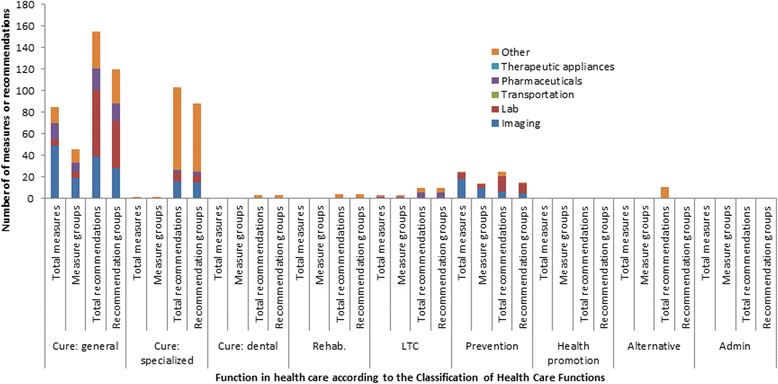Are low-value care measures up to the task? A systematic review of the literature
- PMID: 27539054
- PMCID: PMC4990838
- DOI: 10.1186/s12913-016-1656-3
Are low-value care measures up to the task? A systematic review of the literature
Abstract
Background: Reducing low-value care is a core component of healthcare reforms in many Western countries. A comprehensive and sound set of low-value care measures is needed in order to monitor low-value care use in general and in provider-payer contracts. Our objective was to review the scientific literature on low-value care measurement, aiming to assess the scope and quality of current measures.
Methods: A systematic review was performed for the period 2010-2015. We assessed the scope of low-value care recommendations and measures by categorizing them according to the Classification of Health Care Functions. Additionally, we assessed the quality of the measures by 1) analysing their development process and the level of evidence underlying the measures, and 2) analysing the evidence regarding the validity of a selected subset of the measures.
Results: Our search yielded 292 potentially relevant articles. After screening, we selected 23 articles eligible for review. We obtained 115 low-value care measures, of which 87 were concentrated in the cure sector, 25 in prevention and 3 in long-term care. No measures were found in rehabilitative care and health promotion. We found 62 measures from articles that translated low-value care recommendations into measures, while 53 measures were previously developed by institutions as the National Quality Forum. Three measures were assigned the highest level of evidence, as they were underpinned by both guidelines and literature evidence. Our search yielded no information on coding/criterion validity and construct validity for the included measures. Despite this, most measures were already used in practice.
Conclusion: This systematic review provides insight into the current state of low-value care measures. It shows that more attention is needed for the evidential underpinning and quality of these measures. Clear information about the level of evidence and validity helps to identify measures that truly represent low-value care and are sufficiently qualified to fulfil their aims through quality monitoring and in innovative payer-provider contracts. This will contribute to creating and maintaining the support of providers, payers, policy makers and citizens, who are all aiming to improve value in health care.
Keywords: Low-value care; Measures; Performance measures; Quality improvement.
Figures


Similar articles
-
Interventions for preventing and reducing the use of physical restraints for older people in all long-term care settings.Cochrane Database Syst Rev. 2023 Jul 28;7(7):CD007546. doi: 10.1002/14651858.CD007546.pub3. Cochrane Database Syst Rev. 2023. PMID: 37500094 Free PMC article.
-
Home treatment for mental health problems: a systematic review.Health Technol Assess. 2001;5(15):1-139. doi: 10.3310/hta5150. Health Technol Assess. 2001. PMID: 11532236
-
Systemic pharmacological treatments for chronic plaque psoriasis: a network meta-analysis.Cochrane Database Syst Rev. 2021 Apr 19;4(4):CD011535. doi: 10.1002/14651858.CD011535.pub4. Cochrane Database Syst Rev. 2021. Update in: Cochrane Database Syst Rev. 2022 May 23;5:CD011535. doi: 10.1002/14651858.CD011535.pub5. PMID: 33871055 Free PMC article. Updated.
-
Effects of consumers and health providers working in partnership on health services planning, delivery and evaluation.Cochrane Database Syst Rev. 2021 Sep 15;9(9):CD013373. doi: 10.1002/14651858.CD013373.pub2. Cochrane Database Syst Rev. 2021. PMID: 34523117 Free PMC article.
-
Signs and symptoms to determine if a patient presenting in primary care or hospital outpatient settings has COVID-19.Cochrane Database Syst Rev. 2022 May 20;5(5):CD013665. doi: 10.1002/14651858.CD013665.pub3. Cochrane Database Syst Rev. 2022. PMID: 35593186 Free PMC article.
Cited by
-
Identifying and prioritizing lower value services from Dutch specialist guidelines and a comparison with the UK do-not-do list.BMC Med. 2016 Nov 25;14(1):196. doi: 10.1186/s12916-016-0747-7. BMC Med. 2016. PMID: 27884150 Free PMC article.
-
Strategies to reduce the use of low-value medical tests in primary care: a systematic review.Br J Gen Pract. 2020 Nov 26;70(701):e858-e865. doi: 10.3399/bjgp20X713693. Print 2020 Dec. Br J Gen Pract. 2020. PMID: 33199293 Free PMC article.
-
Estimating the societal costs and benefits of de-implementation of low-value care: developing a modelling approach through case assessment.BMC Health Serv Res. 2025 Jun 2;25(1):783. doi: 10.1186/s12913-025-12948-7. BMC Health Serv Res. 2025. PMID: 40457258 Free PMC article.
-
Development and validation of a new ICD-10-based screening colonoscopy overuse measure in a large integrated healthcare system: a retrospective observational study.BMJ Qual Saf. 2023 Jul;32(7):414-424. doi: 10.1136/bmjqs-2021-014236. Epub 2022 Oct 3. BMJ Qual Saf. 2023. PMID: 36192148 Free PMC article.
-
Overuse in cancer care: do European studies provide information useful to support policies?Health Res Policy Syst. 2018 Feb 20;16(1):12. doi: 10.1186/s12961-018-0287-z. Health Res Policy Syst. 2018. PMID: 29458403 Free PMC article. Review.
References
-
- IOM (Institute of Medicine). Crossing the Quality Chasm: A New Health System for the 21st Century. Washington: National Academy Press; 2001 - PubMed
-
- Bhatia RS, Levinson W, Shortt S, Pendrith C, Fric-Shamji E, Kallewaard M, Peul W, Veillard J, Elshaug A, Forde I, et al. Measuring the effect of Choosing Wisely: an integrated framework to assess campaign impact on low-value care. BMJ Qual Saf. 2015;24(8):523–531. doi: 10.1136/bmjqs-2015-004070. - DOI - PubMed
Publication types
MeSH terms
LinkOut - more resources
Full Text Sources
Other Literature Sources
Medical

